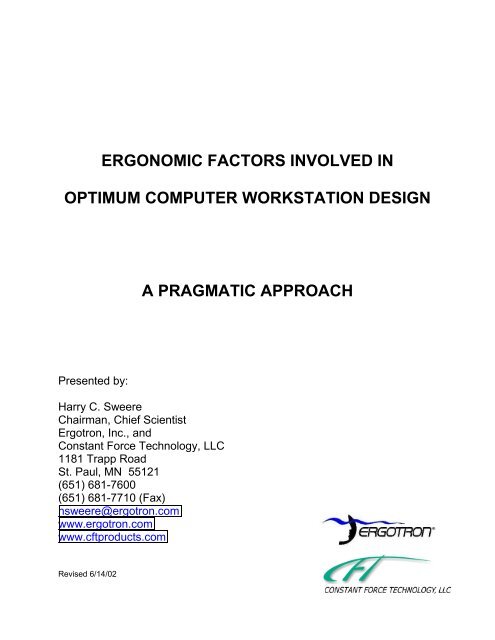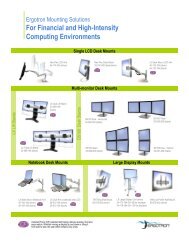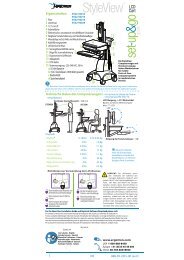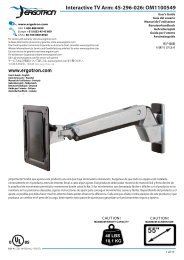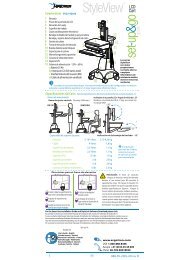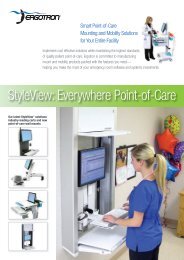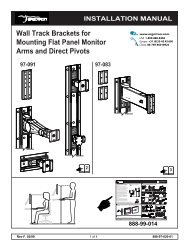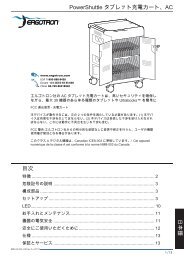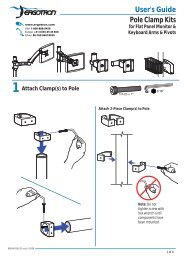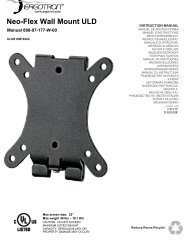ergonomic factors involved in good workstation design - Ergotron
ergonomic factors involved in good workstation design - Ergotron
ergonomic factors involved in good workstation design - Ergotron
You also want an ePaper? Increase the reach of your titles
YUMPU automatically turns print PDFs into web optimized ePapers that Google loves.
ERGONOMIC FACTORS INVOLVED IN<br />
OPTIMUM COMPUTER WORKSTATION DESIGN<br />
Presented by:<br />
Harry C. Sweere<br />
Chairman, Chief Scientist<br />
<strong>Ergotron</strong>, Inc., and<br />
Constant Force Technology, LLC<br />
1181 Trapp Road<br />
St. Paul, MN 55121<br />
(651) 681-7600<br />
(651) 681-7710 (Fax)<br />
hsweere@ergotron.com<br />
www.ergotron.com<br />
www.cftproducts.com<br />
Revised 6/14/02<br />
A PRAGMATIC APPROACH
ERGONOMIC FACTORS INVOLVED IN<br />
OPTIMUM COMPUTER WORKSTATION DESIGN<br />
A PRAGMATIC APPROACH<br />
Ergonomics: Application of scientific knowledge to the work place <strong>in</strong> an effort to improve the<br />
well be<strong>in</strong>g and efficiency of workers.<br />
Background<br />
“The future…depends on how we develop human <strong>in</strong>terfaces that create a<br />
match between the <strong>in</strong>ternal rhythms of the operator and the computer.”<br />
– Dr. Joel Orr, Computer Graphics Consultant –<br />
Over the past several years numerous scientific papers have been written on the <strong>ergonomic</strong><br />
<strong>factors</strong> <strong><strong>in</strong>volved</strong> <strong>in</strong> computer <strong>workstation</strong> <strong>design</strong>. This paper will not attempt to duplicate the<br />
large base of scientific knowledge and the many <strong>ergonomic</strong> studies already well documented.<br />
The goal of this paper is to offer a practical guide to <strong>in</strong>terpret<strong>in</strong>g published <strong>ergonomic</strong> guidel<strong>in</strong>es<br />
and the anthropometric data that can be used to create a user friendly, <strong>ergonomic</strong>ally correct<br />
computer work environment.<br />
Many <strong>factors</strong> are <strong><strong>in</strong>volved</strong> <strong>in</strong> the <strong>design</strong> of a computer <strong>workstation</strong> such as:<br />
• VDT adjustability<br />
• Keyboard placement/adjustability<br />
• Worksurface adjustability<br />
• Chair <strong>design</strong>/adjustability<br />
• Foot rests<br />
• Wrist rests<br />
1<br />
• Glare screens<br />
• Light<strong>in</strong>g, task light<strong>in</strong>g<br />
• Ease of adjustability<br />
• Accessibility to components<br />
• Human Computer Interfaces (HCI’s)<br />
• Space sav<strong>in</strong>gs<br />
All of the above issues concern themselves with the reduction or elim<strong>in</strong>ation of a class of<br />
physical disorders associated with poor <strong>ergonomic</strong> <strong>design</strong> known as Musculoskeletal Stress<br />
Disorders (MSD’s), which result <strong>in</strong>:<br />
• Eye, neck and back stra<strong>in</strong><br />
• Fatigue, headache<br />
• Wrist, hand, elbow and shoulder diseases<br />
Carpal Tunnel Syndrome<br />
Tenosynovitis<br />
Tendonitis<br />
Synovitis<br />
Some of the primary causes of eye, neck and back stra<strong>in</strong>, which cause visual problems and<br />
wrist, hand, elbow and shoulder diseases are:<br />
• Improper VDT screen height and the <strong>in</strong>ability to adjust the screen height to <strong>in</strong>dividual<br />
preferences<br />
• Improper VDT view<strong>in</strong>g distance and the <strong>in</strong>ability to adjust the same
• Improper VDT view<strong>in</strong>g angle and the difficulty of adjust<strong>in</strong>g the view<strong>in</strong>g angle especially of<br />
larger monitors<br />
• Improper keyboard vertical, fore and aft and tilt position<strong>in</strong>g.<br />
A user survey conducted several years ago (Grandjean, et al, 1983) <strong>in</strong>dicated that monitor<br />
position<strong>in</strong>g was a prime factor <strong>in</strong> assur<strong>in</strong>g a computer operator’s comfort. The results of that<br />
survey are shown below:<br />
Response<br />
Survey Questions Yes No<br />
Is a height adjustable screen useful? 97% 3%<br />
Should the screen distance be adjustable? 97% 3%<br />
Should the <strong>in</strong>cl<strong>in</strong>ation (tilt<strong>in</strong>g) of the screen be adjustable? 92% 8%<br />
Although not <strong>in</strong>cluded above, the desirability of provid<strong>in</strong>g keyboard placement and height<br />
adjustability has subsequently been documented extensively because of the high <strong>in</strong>cidence of<br />
Carpal Tunnel Syndrome and other health issues associated with key<strong>in</strong>g functions.<br />
Because of the key role played by the monitor and keyboard, this paper will focus on the<br />
relevant anthropometric data deal<strong>in</strong>g with various classes of operators and the application of a<br />
series of scientifically sound <strong>ergonomic</strong> rules to determ<strong>in</strong>e suggested mount<strong>in</strong>g heights for<br />
these important components of computer <strong>workstation</strong>s.<br />
History/Background<br />
The Expand<strong>in</strong>g “Workstation Environment”<br />
Recent advances <strong>in</strong> network<strong>in</strong>g technology have allowed users to br<strong>in</strong>g computers to the po<strong>in</strong>t<br />
of use <strong>in</strong> many applications and locations heretofore not considered a computer <strong>workstation</strong>.<br />
Accord<strong>in</strong>gly, the desktop can no longer be considered the only focus for the corporate<br />
Ergonomist or the <strong>ergonomic</strong> <strong>workstation</strong> <strong>design</strong>er. Computers on the factory floor, <strong>in</strong><br />
warehouses and <strong>in</strong> hospital rooms are some examples of non-office computer <strong>workstation</strong>s that<br />
have become quite common over the last several years. Many of these new applications<br />
require a different man-mach<strong>in</strong>e <strong>in</strong>terface from the traditional seated desk arrangement<br />
considered <strong>in</strong> much of the published literature. New work positions such as stand<strong>in</strong>g, and sitstand<br />
have been added, along with a variety of computer component mount<strong>in</strong>g options <strong>in</strong>clud<strong>in</strong>g<br />
wall mount, ceil<strong>in</strong>g mount, floor mount and mobile applications. In most of these applications,<br />
component adjustability is even more important than <strong>in</strong> the office environment. In many cases<br />
several people may operate the same equipment on the same or different work shifts as<br />
opposed to the desktop environment which may be fairly static once the equipment is set up for<br />
a particular operator.<br />
In each case <strong>good</strong> <strong>ergonomic</strong> <strong>design</strong> pr<strong>in</strong>ciples must be applied to give the operator or a range<br />
of operators the optimum man-mach<strong>in</strong>e <strong>in</strong>terface and the adjustability required to prevent<br />
discomfort and prevent workplace <strong>in</strong>juries. In many cases the specialized video display<br />
mount<strong>in</strong>g technology developed for these work environments can be applied to the desktop to<br />
provide <strong>ergonomic</strong> adjustability and space sav<strong>in</strong>g benefits for this environment as well.<br />
2
New Display Technology<br />
The advent of new flat screen VDT technology offers new opportunities to provide improved<br />
<strong>ergonomic</strong>s <strong>in</strong> office and specialty computer <strong>workstation</strong> environments. The smaller size and<br />
lighter weight of these devices has fostered the development of new mount<strong>in</strong>g solutions that can<br />
more easily address the age-old problems of screen height adjustability, screen distance and<br />
screen tiltability. Now VDT and other manufacturers can provide low-cost, vertically adjustable<br />
desk stands and easy monitor tilt capability, to address the average range of operators <strong>in</strong> either<br />
sitt<strong>in</strong>g or stand<strong>in</strong>g applications. In addition, specialty devices are available to provide<br />
reasonable cost solutions to address special <strong>ergonomic</strong> issues such as provid<strong>in</strong>g screen<br />
distance adjustability, comfortable view<strong>in</strong>g for bifocal users, sit-stand applications and provid<strong>in</strong>g<br />
vertical adjustability for the 5% female – 95% male range of operators (see chart on Page 4).<br />
Ergonomic Ground Rules<br />
The recommended mount<strong>in</strong>g heights, and range of adjustability required to provide comfortable<br />
use by a range of operators, shown <strong>in</strong> this paper are based upon the follow<strong>in</strong>g <strong>ergonomic</strong><br />
ground rules gleaned from the available scientific literature and published standards on this<br />
subject:<br />
Screen Height<br />
The recommended screen height for VDT monitors (except <strong>in</strong> special circumstances such as<br />
bifocal use) is that the top of the monitor screen should be set at or slightly below<br />
(approximately 1”-2”) the eye height of the user when the user is sitt<strong>in</strong>g or stand<strong>in</strong>g <strong>in</strong> a<br />
comfortable, relaxed position. Whenever possible the screen height should be variable to<br />
accommodate personal preferences throughout the day.<br />
Screen Tilt<br />
Ideally an upward tilt with the bottom of the screen tilted toward the operator provides optimum<br />
view<strong>in</strong>g because it provides a consistent focal length when scann<strong>in</strong>g from the top of the screen<br />
to the bottom. A tilt range of 12° to 20° is ideal depend<strong>in</strong>g upon the size of the monitor. Note:<br />
When upward tilt is used, special care must be taken to m<strong>in</strong>imize screen glare.<br />
Screen Distance from Operator<br />
Normally the monitor screen should be placed as far away as possible from the operator,<br />
consistent with the ability to read the <strong>in</strong>formation presented on the screen. (The normal focal<br />
length for most people exceeds 30” or greater, however, from a practical standpo<strong>in</strong>t a<br />
recommended view<strong>in</strong>g distance from 18” to 28” is mentioned by several <strong>ergonomic</strong> standards.)<br />
A <strong>good</strong> rule of thumb for most <strong>in</strong>stallations is that the monitor screen should be placed at arms<br />
length, with the provision to move the monitor back and forth to suit <strong>in</strong>dividual needs be<strong>in</strong>g the<br />
ideal.<br />
Keyboard Height/Position<strong>in</strong>g<br />
Keyboards should be placed at a height that allows the operator to operate the keyboard with<br />
the forearms level and hands slop<strong>in</strong>g slightly downward. A negatively tilt<strong>in</strong>g keyboard, allow<strong>in</strong>g<br />
the operator to “keep the wr<strong>in</strong>kles out of the top of the wrists” is ideal. Fore and aft position<strong>in</strong>g<br />
of the keyboard should be consistent with allow<strong>in</strong>g the hands to move easily over the keyboard<br />
3
with forearms level and elbows at the sides, ma<strong>in</strong>ta<strong>in</strong><strong>in</strong>g a 90° - 110° angle between upper and<br />
lower arms.<br />
Screen/Keyboard Height Variance<br />
Anthropometric data for the average range of male to female operators <strong>in</strong>dicates that the top of<br />
the monitor screen to centerl<strong>in</strong>e of the keyboard placement should range from 20” to 22” with<br />
21” be<strong>in</strong>g a <strong>good</strong> set-up for most applications.<br />
Visual Representation of Anthropometric Height Range<br />
Anthropometric Data: Relat<strong>in</strong>g to Screen and Keyboard Height Position<strong>in</strong>g<br />
Anthropometric Data* (<strong>in</strong> <strong>in</strong>ches) for Average Range of Operators<br />
* Based on an 1988 Anthropometric Survey of US Army Personnel<br />
Ergonomic Design Factors Gleaned from the Above Anthropometric Table<br />
Note 1<br />
5% Female<br />
Average Male<br />
Average Person<br />
Average Female<br />
Average Range<br />
of Operators<br />
- 50% -<br />
Eye Height Elbow Height<br />
• Eye height variance for the average range of male to female operators<br />
• Design criteria used for <strong>design</strong> of a 6” vertically adjustable VDT mount<strong>in</strong>g apparatus<br />
4<br />
95% Male<br />
Stand Sit Variance Stand Sit Variance Stand Sit<br />
Av. Female 59.4 44.0<br />
5<br />
15.4<br />
4<br />
38.8 23.0<br />
5<br />
15.8 20.6 21.0<br />
Av. Person 61.7 46.1 15.6 40.4 24.9 15.5 21.3 21.2<br />
Av. Male 64.4 48.5 15.9 42.5 27.0 15.5 21.9 21.5<br />
Variance F/M 5.0 4.5 1 3.7 4.0 2<br />
Eye/Elbow<br />
Height Variance<br />
3
Note 2<br />
• Elbow height variance for the average range of male to female operators<br />
• Design criteria used for <strong>design</strong> of most adjustable keyboard mounts<br />
Note 3<br />
• Eye to elbow height variance for the average range of male to female operators<br />
• Optimum top of screen to centerl<strong>in</strong>e (C/L) of keyboard relationship for most computer<br />
<strong>workstation</strong>s – average 21”<br />
Note 4<br />
• Eye height to eye height variance for the average stand<strong>in</strong>g to sitt<strong>in</strong>g person<br />
• Ideal mount<strong>in</strong>g height for fixed height <strong>workstation</strong> components that must <strong>in</strong>terface to a range<br />
of operators<br />
• Design height adjustment range for a m<strong>in</strong>imum height adjustable screen/ keyboard sit-stand<br />
<strong>workstation</strong><br />
Note 5<br />
• Eye and elbow height variances for the average stand<strong>in</strong>g male to the average sitt<strong>in</strong>g female<br />
• Design height adjustment range for a sit-stand <strong>workstation</strong> <strong>design</strong>ed to accommodate the<br />
average range of male and female operators – 20”<br />
Anthropometric Data* (<strong>in</strong> <strong>in</strong>ches)<br />
for 5% Female and 95% Male Range of Operators<br />
* Based on an 1988 Anthropometric Survey of US Army Personnel<br />
Ergonomic Design Factors Gleaned from the Above Anthropometric Table<br />
Note 1<br />
Eye Height Elbow Height<br />
Stand Sit Variance Stand Sit Variance Stand Sit<br />
5% Female 55.7 40.8<br />
4<br />
14.9 36.5 20.8 15.7 19.2 20.0<br />
95% Male 68.6 52.1 16.5 45.4 29.5 15.9 23.2 22.6<br />
Variance 12.9 11.3 1 8.9 8.7 2<br />
• Eye height variance for the 5% female to 95% male operator<br />
• Ideal eye height adjustment range for a broad range of applications<br />
• Design criteria used for <strong>design</strong> of 12” or greater vertically adjustable VDT mount<strong>in</strong>g<br />
apparatus<br />
5<br />
Eye/Elbow<br />
Height Variance<br />
3
Note 2<br />
• Elbow height variance for the 5% female to 95% male operator<br />
Note 3<br />
• Eye/elbow height variance for the 5% female to 95% male operator. Range 19.2” to 23.6”,<br />
average = 21.2”<br />
Note 4<br />
• Eye height variance for the 5% sitt<strong>in</strong>g female to the 95% stand<strong>in</strong>g male<br />
• This data <strong>in</strong>dicates that to <strong>design</strong> a sit-stand <strong>workstation</strong> to address the 5% to 95% range of<br />
female to male operators would require 27.8” of vertical adjustability<br />
Design of an Ergonomically Correct Sitt<strong>in</strong>g Computer Workstation<br />
The follow<strong>in</strong>g chart illustrates a computer <strong>workstation</strong> environment with monitor and keyboard<br />
position<strong>in</strong>g <strong>design</strong>ed accord<strong>in</strong>g to the above <strong>ergonomic</strong> ground rules and anthropometric data.<br />
Notes:<br />
1. View<strong>in</strong>g distance – operator’s eye to screen – 24”<br />
2. Operator eye height – average male 48.5”, average female 44” or as determ<strong>in</strong>ed by<br />
<strong>design</strong>er<br />
3. Top of monitor screen – 1” below eye height<br />
6
4. First l<strong>in</strong>e of text on monitor screen – 5° below horizontal l<strong>in</strong>e of sight<br />
5. Ideal view<strong>in</strong>g cone – 5° to 35° below horizontal l<strong>in</strong>e of sight<br />
6. Center l<strong>in</strong>e of text on screen – 15° to 20° below horizontal l<strong>in</strong>e of sight<br />
7. Bottom of monitor screen – dependent upon size of monitor. Screen heights for<br />
standard 4 x 3 format monitors are 15” D = 9”; 17” D = 10”; 18” D = 11”; 20” D = 12”<br />
8. Tilt angle of monitor – 12° to 18° dependent upon size of monitor, larger monitors require<br />
more tilt to provide equal focal length<br />
9. Worksurface height (29”) – shown <strong>in</strong> relation to bottom of monitor screen for average<br />
female operator<br />
10. Worksurface height (29”) – shown <strong>in</strong> relation to bottom of monitor screen for average<br />
male operator<br />
11. Anthropometric eye height variance, male to female, sitt<strong>in</strong>g application – 4.5”<br />
12. Anthropometric eye height to C/L of keyboard variance – 21”<br />
Note: The average eye heights shown are useful when <strong>design</strong><strong>in</strong>g a height adjustable<br />
<strong>workstation</strong> or desk stand for the average range of operators. However, the dimensional<br />
relationships can be utilized to <strong>design</strong> a static <strong>workstation</strong> for any height operator.<br />
Examples of Ergonomically Adjustable Workstations whose Design is Based on the<br />
Above Anthropometric Data<br />
Tilt +15°/-15°<br />
55”<br />
(1397mm)<br />
Factory <strong>workstation</strong> <strong>design</strong>ed to address the 5% female to 95% male population.<br />
7<br />
12”<br />
(305mm)<br />
21”<br />
(533mm)<br />
Floor<br />
Screen height adjustment<br />
Screen/keyboard height<br />
variance
Hospital <strong>workstation</strong> <strong>design</strong>ed to provide a m<strong>in</strong>imum sit-stand <strong>workstation</strong> for the average range<br />
of personnel.<br />
Hospital <strong>workstation</strong> for stand<strong>in</strong>g application, which provides 9” of vertical adjustability and<br />
correct screen to keyboard centerl<strong>in</strong>e relationship. Note: 9” adjustment range is allocated 2”<br />
above and 2” below the average adjustment range to provide view<strong>in</strong>g and key<strong>in</strong>g comfort for a<br />
broader range of users.<br />
8<br />
Height adjustment<br />
range<br />
Screen/keyboard<br />
variance
Flat Panel Monitor Technology Offers Potential for Improved Ergonomic Benefits<br />
Flat Panel Arm Office Systems Furniture Automation<br />
Flat Panel Monitor shown at 41” screen height, which is the eye height of the 5% female<br />
operator <strong>in</strong> a sitt<strong>in</strong>g position.<br />
Flat Panel Monitor shown at 46” screen height, which is the eye height of the average operator<br />
<strong>in</strong> a sitt<strong>in</strong>g position.<br />
Flat Panel Monitor shown at 52” screen height, which is the eye height of the 95% male<br />
operator <strong>in</strong> a sitt<strong>in</strong>g position.<br />
9
Flat Panel Arm Office Systems Furniture Automation<br />
Top view. Flat Panel Monitor <strong>in</strong>stallation featur<strong>in</strong>g 5% - 95% vertical adjustability, fore and aft<br />
adjustability, monitor tilt and space area for reference materials.<br />
Flat Panel Monitor shown <strong>in</strong> position optimized for bifocal users.<br />
Low-cost, Full-range Ergonomically Adjustable Desk Stands<br />
Newly developed, low-cost l<strong>in</strong>ear counterbalance technology will now allow flat panel monitor<br />
and other manufacturers to provide full <strong>ergonomic</strong> adjustability.<br />
10
Design of an Ergonomically Correct Desk Stand to meet the average range of male and<br />
female users<br />
Eye Height <strong>in</strong> Inches<br />
Stand Sit<br />
Av. Female 59.4 44.0<br />
Av. Male 64.4 48.5<br />
Variance F/M 5.0 4.5<br />
Landscape Portrait<br />
Dual Stacked Flat Panel Monitor Configurations<br />
Dual stacked Flat Panel Monitors do not lend themselves to standard <strong>ergonomic</strong> height rules.<br />
In general, the monitors should be set as close to the tabletop as possible, consistent with the<br />
ability to create a top to bottom parabolic to improve sight l<strong>in</strong>es. Lower is better than higher<br />
because it is more comfortable for the operator to look down than look up for susta<strong>in</strong>ed periods.<br />
11
Conclusion - Summary<br />
Improv<strong>in</strong>g the Human Interface with Computers<br />
Ergonomic studies done years ago <strong>in</strong>dicate that screen position<strong>in</strong>g and keyboard adjustability<br />
are some of the most important <strong>factors</strong> <strong>in</strong> provid<strong>in</strong>g a comfortable work environment and<br />
prevent<strong>in</strong>g a broad range of MSD’s associated with computer use. Disorders such as eye, neck<br />
and back stra<strong>in</strong>, fatigue, headaches, and wrist, hand, elbow and shoulder diseases such as<br />
Carpal Tunnel Syndrome can all be dramatically improved through use of <strong>good</strong> <strong>ergonomic</strong><br />
<strong>design</strong>.<br />
The forego<strong>in</strong>g paper is based upon sound <strong>ergonomic</strong> ground rules and scientific anthropometric<br />
data, which can be used by computer <strong>workstation</strong> <strong>design</strong>ers to help provide an optimum human<br />
<strong>in</strong>terface for their computers. However, the science of <strong>ergonomic</strong>s is constantly evolv<strong>in</strong>g,<br />
therefore all values and recommendations <strong>in</strong> this paper are provided as guidel<strong>in</strong>es only.<br />
Workstation <strong>design</strong>ers are urged to consult with a certified Ergonomist who is familiar with the<br />
applicable anthropometric data and computer <strong>workstation</strong> <strong>ergonomic</strong> standards for corroboration<br />
of the recommendations made for each application.<br />
12


